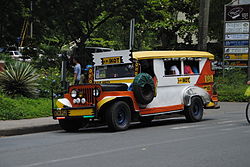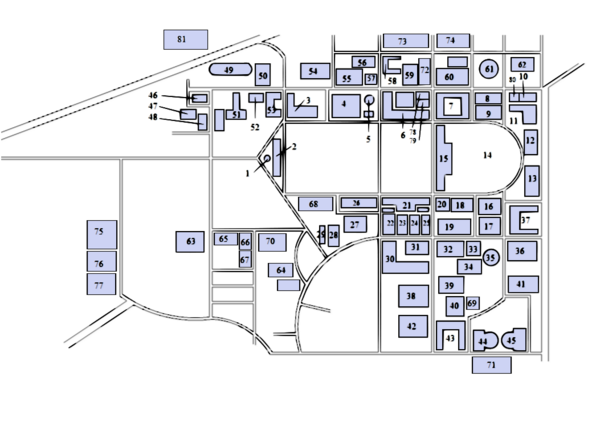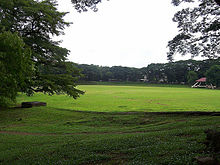- University of the Philippines Diliman
-
Not to be confused with University of the Philippines.
University of the Philippines Diliman Unibersidad ng Pilipinas Diliman 
Official sealMotto Honor and Excellence Established 18 June 1908 (system)
12 February 1949 (campus)Type National university
Flagship
PublicChancellor Dr. Caesar A. Saloma (since March 2011)[1] President Alfredo Pascual Students 23,333 Location  Quezon City, Metro Manila, Philippines
Quezon City, Metro Manila, Philippines
14°39′17.50″N 121°3′52.09″E / 14.654861°N 121.0644694°ECoordinates: 14°39′17.50″N 121°3′52.09″E / 14.654861°N 121.0644694°ECampus 1,218.23 acres (4.9300 km2)[2] Hymn "U.P. Naming Mahal" Nickname Fighting Maroons Mascot U.P. Oblation Affiliations APRU, ASAIHL, ASEA UNINET
AUN and UAAPWebsite upd.edu.ph 
The University of the Philippines Diliman (UP Diliman, UPD, UPDil, or informally, Peyups[3]), is a coeducational and public research university located in Quezon City, Philippines. It is the flagship university, seat of administration, and the fourth oldest constituent university of the University of the Philippines System.[4] It includes the two extension program campuses in Pampanga and Olongapo City.
In 1948, the newly-established Republic of the Philippines sited an area now known as Quezon City as the nation's capital. The next year, the university acquired a 493-hectare area in the Diliman district of the city.[2] The new campus was named University of the Philippines Diliman and was assigned to be the university's seat of administration and main campus. Since its establishment in 1949, UP Diliman has expanded into offering more than 296 graduate, undergraduate and diploma courses,[5] with nine units declared as Centers of Excellence by the Commission on Higher Education as of 2009, currently the highest number recognized by this agency.[6] Between the 70s and 80s, UP Diliman was the site of much student activism.[7] It was during these times that student demonstration and opposition against Marcos' administration became heavy and aggressive. This was one of the precursors to Marcos' declaration of martial law in 1972.[8]
Notable research units of UP Diliman include:Marine Science Institute, National Institute of Geological Sciences, National Institute of Physics, National Institute of Molecular Biology and Biotechnology-Diliman, and the National Institute for Science and Mathematics Education Development, which are all pioneers of science research and development in the Philippines.[4] Its athletic teams, called the Fighting Maroons, are members of the University Athletic Association of the Philippines (UAAP). while its cheerdance group, Pep Squad, represents the university in the UAAP Cheerdance Competition.
Contents
Campus
The UP Ikot Jeepney Shuttle Service
UP Diliman has a total land area of 493 hectares.[2] Much of this property is utilized by the university in the form of building infrastructures and research facilities, while the remaining area is forested, reserved for development and residential use, or unoccupied.
The main campus, the science and technology parks located on the eastern and western sides of the university, and the residential(Area 2) and Barangay UP Campus communities stretching from the western side to the northern tip of the university comprise the area most actively used by UP Diliman.
Road map of UP DilimanLabels:
1. Oblation statue
2. UP System Administration (Manuel Quezon Hall)
3. College of Music
4. UP Theater and Film Institute
5. UP Carillon Tower
6. College of Engineering (Alejandro Melchor Hall)
7. National Engineering Center (Alfredo Juinio Hall)
8. UP Law Center (Jorge Bocobo Hall)
9. College of Law (George Malcolm Hall)
10. Asian Center (Carlos Romulo Hall)
11. School of Economics (Jose Encarnacion, Jr. Hall)
12. College of Business Administration
13. Student Activity Center (Wenceslao Q. Vinzons Hall)
14. Gen. Antonio Luna Parade Grounds (Sunken Garden)
15. UP Main Library (Bienvenido Gonzalez Hall)
16. College of Education (Conrado Benitez Hall)
17. UP Integrated School
18. Department of Psychology (Guy Potter Benton Hall)
19. Institute of Biology
20. Center for International Studies
21. College of Social Sciences and Philosophy (Rafael Palma Hall)
22. Palma Hall Pavilion 1 (formerly Institute of Chemistry)
23. Palma Hall Pavilion 2 (formerly Institute of Chemistry)
24. Llamas Science Hall (formerly National Institute of Physics)
25. Palma Hall Pavilion 4 (Institute of Biology lecture halls)
26. Bulwagang Jose Rizal/Faculty Center (Jose Rizal Hall)
27. College of Arts and Letters
28. Office of the University Registrar
29. Office of Admissions
30. National Institute for Science and Mathematics Education Development
31. UP Information Technology Training Center (Vidal Tan Hall)
32. Natural Sciences Research Institute
33. Diliman Learning Resource Center (Gerardo Roxas Building)
34. Sampaguita Residence Hall
35. College of Home Economics Gusali 2
36. College of Home Economics (Teodora Alonzo Hall)
37. Narra Residence Hall
38. Electrical and Electronics Engineering Institute
39. Marine Science Institute
40. College of Science Library and Administration Building
41. Institute of Chemistry
42. Department of Computer Science (UP Alumni Engineers' Centennial Hall)
43. National Institute of Geological Sciences
44. Institute of Mathematics
45. National Institute of Physics
46. School of Labor and Industrial Relations (Andres Bonifacio Hall)
47. National College of Public Administration and Governance
48. Institute for Small Scale Industries (E. Virata Hall)
49. College of Human Kinetics/UP Gym
50. Department of Military Science and Tactics (Vanguard Building)
51. College of Social Work and Community Development (Melchora Aquino Hall)
52. UP Center for Women's Studies
53. College of Mass Communication (Plaridel Hall)[note 1]
54. Alumni Center
55. Bahay ng Alumni (Alumni House)
56. Sanggumay Graduate Women's Residence Hall
57. Molave Residence Hall
58. Kalayaan Residence Hall
59. Yakal Residence Hall
60. School of Statistics
61. University Pool/Arcade
62. Ilang-Ilang Residence Hall
63. College of Fine Arts (Murray Bartlett Hall)
64. College of Architecture (Aurelio Juguilon Hall)
65. National Institute of Molecular Biology and Biotechnology (Albert Hall)
66. Archaeological Studies Program (Villadolid Hall)
67. Seaweed Chemistry Building
68. Jorge B. Vargas Museum and Filipiniana Research Center
69. Institute of Environment Science and Meteorology
70. UP Press
71. Advanced Science and Technology Institute
72. Ipil Residence Hall
73. Shopping Center
74. University Health Service (UP Infirmary)
75. Commission on Higher Education
76. Commission on Information and Communications Technology
77. Philippine Institute of Volcanology and Seismology
78. Diliman Interactive Learning Center
79. National Center for Transportation Studies
80. Institute of Islamic Studies (Bulwagang Salaam/Peace Hall)
81. Asian Institute of TourismThe Oblation and Academic Oval
Coming from the Commonwealth Avenue in Quezon City, UP Diliman is connected by a road named as University Avenue. The avenue stretches 800 meters where traffic enters the campus or going towards C.P. Garcia St., which connects Commonwealth Avenue to Katipunan Avenue. At the end of University Avenue, the Oblation Plaza of Diliman campus faces the road. Behind it, the main building façade of the campus can be seen, the Quezon Hall.
Main article: Oblation (University of the Philippines)The Oblation statue (Tagalog: Pahinungod/Oblasyon) is the most iconic figure of the UP System. The statue was originally made by National Artist Guillermo E. Tolentino in 1935 in a collective effort by the students of the UP System.[9] During the 40th anniversary of the University of the Philippines, the Oblation was transferred to Diliman campus as a symbol of transfer of administrative seat. The Oblation was originally naked and made of concrete and stands 3.5 meters in height.[9] To promote morality and censorship, UP President Jorge Bocobo suggested to put fig leaf to cover genitals.[10] In 1950, the Board of Regents ordered the statue to be cast in bronze, which was furnished in Italy and was put into display in 1958.[11]
Several replicas of Tolentino's Oblation statue were created during the creation of new UP campuses, some were made by the National Artist Napoleon Abueva. UP Diliman's Oblation statue located in the Oblation Plaza is also a concrete-made replica of Tolentino's. The original statue is now put on display on the third floor of the university's Main Library.[10]
The main and largest road in the university is the Academic Oval, sometimes known as Acad Oval. This road is composed of two joining avenues, the Roxas and Osmeña Avenues. Having a total circumference of about 2.2 kilometers, the oval connects the rest of the colleges of the university from the main University Avenue. The avenue had its name from several colleges around the oval, namely College of Mass Communication, College of Music, College of Engineering, College of Law, School of Economics, College of Business Administration, College of Education, College of Social Sciences and Philosophy and School of Library and Information Studies. The oval also covers Quezon Hall, the UP Theater, National Engineering Center, Student Activity Center/Vinzons Hall, Center for International Studies and Jorge B. Vargas Museum.[12] Additionally, the Academic Oval is planted with over 500 acacia and fire trees.[12][13]
During the centennial celebration of UP System, UP President Emerlinda Roman rehabilitated the inner circle of the Academic Oval. The transformation included the paving of the inner Oval and creation of commemorative tiles around the walkway for an exchange of price. The efforts are collected and distributed to form the UP Diliman Faculty Development Fund.[14] On March 2008, however, the Academic Oval was turned into one-way in order to lessen traffic volume entering the university. According to Vice Chancellor for Community Affairs Cynthia Grace Gregorio, this policy also promotes to lower air pollution by creating biking lanes on the inner side of the circle.[15]
Carillon Tower
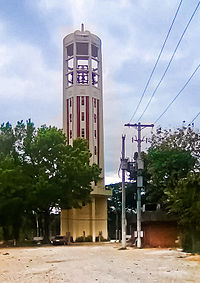 The UP Carillon Tower as seen from Magsaysay Avenue near the UP Film Institute.
The UP Carillon Tower as seen from Magsaysay Avenue near the UP Film Institute.
The only carillon tower in the Philippines and in Southeast Asia that is manually played by a clavier or a wooden keyboard, the UP Carillon towers about 130 feet tall.[16] The UP Carillon was originally constructed in 1940 by National Artist Juan Nakpil, Conservatory of Music director Ramon Tapales and UP President Bienvenido Gonzales with an initial idea of building a concrete structure that may tower the grounds of the university.[17] Several years later, on 1 August 1952, the tower was finished and dedicated as the UP Carillon. Forty-eight bells with four octaves were installed by the Dutch carilloneeur Adrian Antonisse, with the efforts laid by the UP Alumni Association.[17] These bells were forged by Van Bergen Co. in Netherlands and the largest of the them weighs five tons, where the total cost of construction summed up to PhP 200,000.[18]
Apart from playing the UP's anthem UP Naming Mahal (UP Beloved), the Carillon tuned many music such as the Magtanim ay Di Biro (Planting Rice, a Filipino folk song) and The Beatles sounds.[18] One of the most important tunings of the Carillon was when it played the socialist anthem The Internationale at the 1971 Diliman Commune.[19][20] During this time, UP students declared the university as a republic and as a separate entity from the Philippines.[21]
Due to age and rust, the Carillon ceased to play in 1981. In 1988, the last symphonies of UP Naming Mahal and Push On UP! (UP Diliman's athletic cheer) from the tower was played during the December's Lantern Parade. Since then, the Carillon was never tuned.[16] But as late as 2001, students say that they can hear the rhymes of London Bridge Is Falling Down and Sing a Song of Six Pence despite that it was closed to prevent further mishaps.[16]
In 2005, through the collective efforts of UP Alumni Association and various private donors, the UP Carillon Restoration Project of the UP Centennial Commission launched a fund-raising program to collect PhP 20 million to restore the Carillon, as a projection of using the tower again in the coming 100th year of the University of the Philippines.[22] After two years, the Project was able to collect PhP 14 million which will be used to cleanup and repair the tower itself and to replace the bells.[23]
In 2007, the Carillon was formally reintroduced to the public after two years of restoration. The original 48 bells were put into archives and are now replaced by 36 bells bought from Dutch company Petit and Fritsen for PhP 12 million whereas the construction engineers were provided by the Royal Bell Philippines. According to project engineer Matthew Bergers, each bell was made from 80% bronze and 20% combination of zinc, magnesium and phosphorus. At the same time, the largest of these bells weighs 635 kilograms and the smallest weighs 14 kilograms.[16] The original wood claviers were replaced by heavy duty oakwood while all bells are designed to hold refurbished steel pipes.[23] Another project engineer Eduardo Otacan also said that the new bells will have 3 octaves and they can be programmed using computers attached to the clavier.[16]
At the same time, a small amphitheater named Carillon Plaza was constructed at the base of the tower. After about two decades of silence, the UP Carillon was heard again during the Lantern Parade of 2007.[16]
Sunken Garden
- "Sunken Garden" redirects here. For other uses, see Sunken Gardens.
The Gen. Antonio Luna Parade Grounds, or commonly known as the Sunken Garden, is a 5-hectare natural depression found on the eastern side of the campus and at the end of the Academic Oval circle. Sunken Garden is enclosed by the UP Diliman Main Library (also houses the School of Library and Information Studies), College of Social Sciences and Philosophy's Department of Psychology, College of Education, Student Activity Center/Vinzons Hall, College of Business Administration, School of Economics and College of Law. The Grounds was the original property of the UP-ROTC when Diliman campus was founded in 1949.[24]
Gen. Antonio Luna Parade Grounds acquired its name Sunken Garden due to its basin-shaped low-level formation that has the deepest point of 65 meters above sea level (contrary to university's height of over hundreds of meters above sea level).[25] The Sunken Garden is usually the venue for sports tournament like frisbee, soccer, and volleyball clinics as well as the annual UP Fair. Sometimes, ROTC trainings are done here by the Department of Military Science and Tactics.[24]
The Sunken Garden actually sinks by about two inches every year. There are two possible reasons of this sinking: first, it is because of underground trenches that mingle with the campus' sewer system. These trenches branch from the rear side of NIGS building, Sampaguita Residence Hall, the UP Integrated School, down to the National Institute of Physics, until near the former Narra Residence Hall. These trenches then connects to the so-called Marikina Fault Line, an active geologic structure that runs across the east of Metro Manila.[26] Another theory is that the depression was due to the emptying of former streams in the Sunken Garden that were prominent in the 1950s. These streams formerly run from the Katipunan Avenue, going to the garden itself and leaves the campus for the Commonwealth Avenue.[25]
Organization
Chancellors of the
University of the Philippines Diliman[27]Edgardo J. Angara, LL.M., 1982-1983[note 2] Dr. Ernesto G. Tabujara, Sr., 1983–1990 Dr. Jose V. Abueva, 1990-1991[note 3] Dr. Emerlinda R. Roman, 1991–1993 Dr. Roger Posadas,1993–1996 Dr. Claro C. Llaguno, 1996–1999 Dr. Emerlinda R. Roman, 1999–2005 Dr. Sergio S. Cao, 2005–2011 Dr. Caesar A. Saloma, 2011–present Administration
UP Diliman is the fourth oldest and is the largest, in terms of student population, of all the seven major campuses of the University of the Philippines. The University of the Philippines is governed by the Board of Regents' 11 members, of whom five are ex officio, three are student, faculty, and staff representatives, and three are appointed by the President of the Philippines.[28] Each campus of the University of the Philippines is headed by a chancellor. The first chancellor of UP Diliman was Senator Edgardo J. Angara, whose office was created on 26 April 1982.[29] The chancellor is assisted by five vice chancellors — for academic affairs, administration, community affairs, research & development, and student affairs.[30] The current chancellor is Dr. Caesar A. Saloma, who was appointed by the Board of Regents into position during its 1267th meeting on 2 March 2011.[1]
Apart from heading the university, the chancellor also holds administrative duties that represent the Board of Regents at the campus level. The chancellor also serves as chairperson of the university council, an internal coordinating body composed of the chancellor himself, the university registrar who serves as secretary, and the professorial faculty.[31] The vice chancellor for academic affairs, on the other hand, assists the chancellor in coordinating curricular, instructional, library, and other programs of the university. The vice chancellor for administration assists the chancellor in the administrative management of the campus. The vice chancellor for community affairs assists the chancellor in promoting relationships within the university and in dealing with local government and safety issues, while the vice chancellor for research & development assists the chancellor in formulating guidelines and criteria for the university's research and development endeavors. Finally, the vice chancellor for student affairs assists the chancellor in promoting wellness and discipline among students in areas such as health, food services, and scholarship management.[32]
Colleges and institutes
 The Malcolm Hall, named after the college's first dean, Supreme Court Justice George Malcolm houses the College of Law.
The Malcolm Hall, named after the college's first dean, Supreme Court Justice George Malcolm houses the College of Law.
The academic arms of the university are called colleges, institutes, or schools. A number of colleges and schools offer a variety of undergraduate, graduate, and diploma programs, while some offer programs only within a specific field. Most institutes offer no degrees, but provide research facilities for academic development.
Each college or school is headed by a dean, who is appointed by the UP Board of Regents upon the recommendation of the chancellor and the president of the university. The dean acts as the head of the faculty of his college and assumes administrative duties assigned by the Board. The dean has a tenure of three years, which may be extended for up to two terms upon reappointment. The associate dean, on the other hand, assists the dean in the administration of the unit. The tenure of the associate dean is determined by the Board of Regents upon the recommendation of the chancellor and the dean.[33]
Some of UP Diliman's academic arms assume the title of "Institute" (such as the Asian Institute of Tourism or the Institute of Islamic Studies) and function as their own units, with their own departments. Some institutes are within colleges (such as the Institute of Civil Engineering within the College of Engineering). Some of UP Diliman's academic arms also assume the title of "School" (such as the School of Economics), which might function independently and have their own departments or which may operate as a unit within a particular college.
UP Diliman's institutes are headed by institute directors, who assume the duties assigned by the chancellor. Each director has a tenure of three years, which may be extended for up to two terms upon the reappointment of the chancellor. A director cannot not be an academic head of any department or division under his institute. Each college or school is composed of clusters of institutes or departments.
The university's departments are headed by department chairs, who assume the duties assigned by the dean and the chancellor. Each chair is appointed by the chancellor, as recommended by the dean or institute director, and has a tenure of three years, which may be extended for up to two terms upon reappointment.[33]
Some units of the university are known as national institutes, such as the National Institute of Molecular Biology and Biotechnology. The status of being an institute is determined by the Board of Regents, but recognition as a national institute is governed by Philippine legislation.[34] The head of a national institute, also the director, is not appointed by the chancellor but by the president of the university.[33]
UP Diliman is composed of 26 colleges, schools, and institutes. Officially, these are called degree-granting units.[35] The oldest of these colleges is the College of Fine Arts, established in 1908 and originally located in Manila.[36] On the other hand, the first college to operate on the Diliman campus is the Conservatory of Music (then College of Music) in 1949.
- Archaeological Studies Program (ASP)
- Asian Center (Asian Center)
- Asian Institute of Tourism (AIT)
- College of Architecture (CA)
- College of Arts and Letters (CAL)
- College of Business Administration (CBA)
- College of Education (CEduc)
- College of Engineering (COE)
- College of Fine Arts (CFA)
- College of Home Economics (CHE)
- College of Human Kinetics (CHK)
- College of Law (Law)
- College of Mass Communication (CMC)
- College of Music (Music)
- College of Science (CS)
- College of Social Sciences and Philosophy (CSSP)
- College of Social Work and Community Development (CSWCD)
- Institute of Islamic Studies (IIS)
- Institute for Small Scale Industries (ISSI)
- National College of Public Administration and Governance (NCPAG)
- School of Economics (SE)
- School of Labor and Industrial Relations (SOLAIR)
- School of Library and Information Studies (SLIS)
- School of Urban and Regional Planning (SURP)
- School of Statistics (Stat)
- Technology Management Center (TMC)
In addition, the University has units that do not grant degrees:
- Business Research Foundation (BRF)
- Center for International Studies (CIS)
- Center for Integrative and Development Studies (CIDS)
- Department of Military Science and Tactics (DMST)
- Development Center for Finance (DCF)
- DNA Analysis and Genetic Engineering Laboratory
- Jorge B. Vargas Museum and Filipiniana Research Center
- Local Government Center
- National Engineering Center (NEC)
- National Center for Transportation Studies (NCTS)
- National Hydraulics Research Center (NHRC)
- National Institute for Science and Mathematics Education Development (NISMED)
- Sentro ng Wikang Filipino (Center for Filipino Language, SWF)
- Training Center for Applied Geodesy and Photogrammetry (TCAGP)
- Third World Studies Center (TWSC)
- UP Computer Center (UPCC)
- UP Information Technology Training Center (UPITTC)
- UP Center for Women's Studies (CWS)
- UP Creative Writing Center
- UP Diliman Main Library
- UP Law Center
Commission on Higher Education (as of Oct.4, 2010)[37]
Center of Excellence
- Information Technology
- Chemistry
- Geology
- Molecular Biology
- Physics
- Statistics
- Marine Science
- Mathematics
Academics
- See List of UP Diliman student organizations for a list of University student organizations.
Academic Year Enrollment 2006–2007 21,788 2007–2008 22,148 [38] 2008–2009 23,333 [39] 2009–2010 22,568 [40] Culture, sports and traditions
The Diliman community is sometimes referred to as the Diliman Republic and a "microcosm of the Philippines". It is the only university in Metro Manila that has its own jeepney transportation system due to its expansiveness. The university also has a congressional franchise to operate two radio stations (AM and FM) as well as a television station. Currently, the university only operates DZUP 1602, a community AM radio station. The campus encompasses a number of residential areas and many students claim a sense of solidarity with the residents of these immediate communities.
U.P. Diliman represents the U.P. System in the University Athletic Association of the Philippines (UAAP) and participates in all events. The Fighting Maroons have perennially placed in the top three in the overall points race of the UAAP.
Two of the most-awaited events in the campus are the Lantern Parade, held on the last week before the Christmas break, and the U.P. Fair, held every February. During the Lantern Parade, groups within the University create Christmas lanterns and floats and parade around the Academic Oval. The U.P. Fair, organized by the UP Diliman University Student Council, is a week-long event held at the Sunken Garden that features nightly music concerts, booths, and amusement park rides.
Centennial Celebration
On January 8, 2008, the University of the Philippines System (UP), with 7 constituent universities and 12 campuses offering 258 undergraduate and 438 graduate programs, began its centennial celebration at the Diliman campus. The university has produced 7 of 14 presidents, 12 chief justices of the Supreme Court, 34 of 35 national scientists and 36 of 57 national artists, and an estimated 250,000 alumni (15,000 doctors, 8,000 lawyers and 23,000 teachers).[41]
Fernando Javier, 100, of Baguio City, oldest UP alumnus (Civil Engineering from University of the Philippines Manila, 1933), carried the 100-torch relay at the UP academic oval in Diliman, Quezon City. The 99th torchbearer was Michael Reuben Dumlao, youngest, a 6th-grader from the University of the Philippines Integrated School in UP Diliman. UP president Emerlinda Roman, first woman president, carried the 100th torch and ignited the centennial cauldron in the UP Oblation.[42]
The cauldron featured 3 pillars representing the core values of Excellence, Leadership, and Service and 7 flowers representing the constituent universities, to wit, UP Manila, UP Diliman (together with UP Pampanga, its extension campus), UP Los Baños, UP Baguio, UP Visayas, UP Mindanao, and UP Open University.[43]
UPAA 2008 Centennial Yearbook
The University of the Philippines Alumni Association announced its launching of a special three-volume UPAA 2008 Centennial Yearbook on June 21, 2008, the UPAA Grand Alumni-Faculty Homecoming and Reunion at the Araneta Coliseum, Cubao, Quezon City. The theme is “UP Alumni: Excellence, Leadership and Service in the Next 100 Years,” with the three cover designs showing the works of national artists Napoleon Abueva, Abdul Imao, and BenCab. Chief Justice Reynato Puno is the Yearbook's most distinguished alumnus awardee (among 46 other awardees).[44]
See also
- DZUP 1602
- Church of the Holy Sacrifice
Notes
- ^ Plaridel is the nom-de-plume of Marcelo H. del Pilar.
- ^ Concurrent President of the University of the Philippines from 1981-1987
- ^ Concurrent President of the University of the Philippines from 1987-1993
References
- ^ a b "Saloma is new UPD Chancellor". UP Newsletter. http://www.upd.edu.ph/~updinfo/index188.html. Retrieved 2011-03-02.
- ^ a b c "UP Diliman History". http://www.up.edu.ph/oldsystem/ups_web_html/upd_hist.htm. Retrieved 4 August 2010. "Archive of the original UP System's website."
- ^ Mayuga, Sylvia; Hans Hoefer, Alfred A. Yuson, Elizabeth Reyes (1989). Philippines (Volume 222 of Insight Guides). APA Productions. p. 140. http://books.google.com/books?id=Yoa6AAAAIAAJ&q=peyups&dq=peyups&hl=en&ei=fCpZTOy4JJPKcb-vuPAI&sa=X&oi=book_result&ct=result&resnum=3&ved=0CC8Q6AEwAg. Retrieved 4 August 2010.
- ^ a b "UP Diliman - University of the Philippines System". University of the Philippines System. http://www.up.edu.ph/content.php?r=2&c=18. Retrieved 2009-05-19.
- ^ "UP Diliman". University of the Philippines. http://www.up.edu.ph/content.php?r=2&c=18. Retrieved 4 August 2010.
- ^ "VIII. CENTERS OF EXCELLENCE, CENTERS OF DEVELOPMENT AND INTERNATIONAL PUBLICATION AWARDEES". UPS Budget Office-Planning Service Division. 2009. http://www.up.edu.ph/pdf/Facts%20and%20Figures%202009.pdf. Retrieved 4 August 2010. "Archived by the University of the Philippines"
- ^ Rodis, Rodel (4 February 2010). "First Quarter Storm remembered". Philippine Daily Inquirer. http://globalnation.inquirer.net/columns/columns/view/20100204-251226/First-Quarter-Storm-remembered. Retrieved 4 August 2010.
- ^ Ellao, Janess Ann (15 July 2010). "‘Sigwa’: Reliving the First Quarter Storm of 1970". Bulatlat.com. http://www.bulatlat.com/main/2010/07/15/sigwa-reliving-the-first-quarter-storm-of-1970/. Retrieved 4 August 2010.
- ^ a b Tan, Michael (19 December 2002). "The Oblation". Pinoy Kasi!. http://pinoykasi.homestead.com/files/2002articles/12192002_Oblation.htm. Retrieved 7 August 2010.
- ^ a b "UP Oblation: History". UP Alumni Association of Greater Chicago. http://upaagc.org/oblation.html. Retrieved 7 August 2010.
- ^ "Oblation by Napoleon Abueva". http://www.oblation.com.ph/history.htm. Retrieved 7 August 2010.
- ^ a b Villar, Eugene Alvin (21 June 2006). "U.P. Diliman Academic Oval". http://www.vistapinas.com/article/up-diliman-academic-oval. Retrieved 7 August 2010.
- ^ Martinez, Glenn. "A Sunday Walk around U.P. Diliman’s Academic Oval". http://traveleronfoot.wordpress.com/2008/06/15/a-sunday-walk-around-up-diliman%E2%80%99s-academic-oval/. Retrieved 7 August 2010.
- ^ "Do you love UP? Then show it!". UP Centennial Commission. http://www.upd.edu.ph/~updinfo/whatsup/upcentennial2.htm. Retrieved 7 August 2010.
- ^ Bibe Jr., Cenon (29 March 2008). "UP reroutes traffic". Philippine Daily Inquirer. http://newsinfo.inquirer.net/inquirerheadlines/metro/view/20080329-127076/UP-reroutes-traffic. Retrieved 7 August 2010.
- ^ a b c d e f Aurelio, Julie (16 December 2007). "Bells of Diliman ring again on Dec. 18". Manila Bulletin. http://newsinfo.inquirer.net/inquirerheadlines/nation/view/20071216-107115/Bells_of_Diliman_ring_again_on_Dec_18. Retrieved 8 August 2010.
- ^ a b Santiago, Bettina (20 December 2007). "For UP the bells toll". Manila Bulletin. http://www.mb.com.ph/node/54306. Retrieved 8 August 2010.
- ^ a b "History of UP Carillon". The University of the Philippines Carillon Tower Restoration Project. http://www.upcarillon.org/history.html. Retrieved 8 August 2010.
- ^ Ordoñez, Elmer (5 April 2008). "Anthem for dedicated youth". Manila Times. http://archives.manilatimes.net/national/2008/apr/05/yehey/opinion/20080405opi2.html. Retrieved 8 August 2010.
- ^ Cervantes, Behn (12 January 2008). "The UP Carillon rings again". Manila Bulletn. http://showbizandstyle.inquirer.net/entertainment/entertainment/view/20080112-111831/The_UP_Carillon_rings_again. Retrieved 8 August 2010.
- ^ Palatino, Mong. "Pagbabalik-tanaw sa Diliman Commune" (in Tagalog). Tinig.com. http://www.tinig.com/v26/v26mong.html. Retrieved 8 August 2010. Google translation
- ^ "History of UP Carillon". The University of the Philippines Carillon Tower Restoration Project. http://www.upcarillon.org/about_project.html. Retrieved 8 August 2010.
- ^ a b de Guzman Jr., Marcos (9 June 2007). "Restoring the UP Carillon’s history". Manila Bulletin. http://showbizandstyle.inquirer.net/lifestyle/lifestyle/view/20070609-70321/Restoring_the_UP_Carillon%92s_history. Retrieved 8 August 2010.
- ^ a b "General Antonio Luna Parade Grounds". UP ROTC. http://www.uprotc.org/facility/gen-antonio-luna-parade-grounds.html. Retrieved 8 August 2010.
- ^ a b Sarmiento, Christine Joy. "The truth behind the myth". UP College of Mass Communication. http://dilimangenius.webs.com/maharlagmay.htm. Retrieved 8 August 2010.
- ^ "Geologic Map of Diliman, Quezon City and the Marikina Fault Line". Philippine Institute of Volcanology and Seismology. http://www.phivolcs.dost.gov.ph/images/active/Hazard%20Maps/Active%20Fault%20Maps/Valley_fault_maps/diliman_q.pdf. Retrieved 8 August 2010.[dead link]
- ^ "Chancellors: Past and Present". University of the Philippines Diliman. http://www.upd.edu.ph/~oc/chancellors.htm. Retrieved 5 August 2010.
- ^ "Republic Act 9500: An Act to Strengthen the University of the Philippines as the National University". University of the Philippines Website. http://www.up.edu.ph/pdf2/RA_9500.pdf. Retrieved 2009-05-19.
- ^ "UP Diliman Faculty Manual". UP Diliman. 2003. p. 3. http://www.upv.edu.ph/downloads/files/UPD_Faculty_Manual.pdf. Retrieved 9 August 2010.
- ^ "Officials of UP Campuses". University of the Philippines. http://www.upd.edu.ph/officials.htm#diliman. Retrieved 5 August 2010.
- ^ "UP Diliman Faculty Manual". UP Diliman. 2003. p. 12. http://www.upv.edu.ph/downloads/files/UPD_Faculty_Manual.pdf. Retrieved 9 August 2010.
- ^ "UP Diliman Faculty Manual". UP Diliman. 2003. pp. 8–9. http://www.upv.edu.ph/downloads/files/UPD_Faculty_Manual.pdf. Retrieved 9 August 2010.
- ^ a b c "UP Diliman Faculty Manual". UP Diliman. 2003. p. 10. http://www.upv.edu.ph/downloads/files/UPD_Faculty_Manual.pdf. Retrieved 9 August 2010.
- ^ Ferdinand Marcos (23 March 1983). "Executive Order 889: Establishing a System of National Centers of Excellence in the Basic Sciences". http://www.lawphil.net/executive/execord/eo1983/eo_889_1983.html. Retrieved 9 August 2010. "The Board of Regents of the University of the Philippines is hereby authorized to organize the above-mentioned institutes, and such other additional institutes and laboratories in the future it may deem proper to create, from out of the existing staff, physical facilities and programs of the University and its constituent units."
- ^ "Academic Programs". UP Diliman. http://www.upd.edu.ph/acad.htm. Retrieved 7 August 2010.
- ^ "About CFA: Celebrating 100 years in 2008". UP College of Fine Arts. http://up-cfa.com/the-college/. Retrieved 7 August 2010.
- ^ text, additional text.
- ^ Opisyal na Pahayagan ng mga Mag-aaral ng Kolehiyo ng Pangmadlang Komunikasyon, Unibersidad ng Pilipinas — Tinig ng Plaridel
- ^ [1]
- ^ [2]
- ^ Inquirer.net, UP in next 100 years
- ^ Inquirer.net, UP passes torch: 100-yr-old to 6th grader
- ^ www.mb.com.ph, UP alumni light perpetual flame at centennial rites
- ^ newsinfo.inquirer.net, UP to launch Centennial Yearbook at June 21 homecoming
External links
- The Main Library - University of the Philippines, Diliman
- University of the Philippines Press
- U.P. Diliman Events
- U.P. iskWiki! Website
- U.P. Diliman Wiki Map
- Tribute to the U.P. Oblation
- GMA NEWS.TV, video, UP students join festive launch of centennial year, 01/08/2008
- U.P. College of Architecture & the Built Environment
Preceded by
Visayas (Cebu College)University of the Philippines campuses by foundation
February 12, 1949 (4th)Succeeded by
BaguioUNIVERSITY OF THE PHILIPPINES DILIMAN 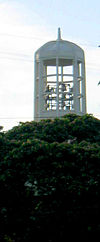
Academics Archaeology • Architecture • Arts & Letters • Asian Center • Business Administration • Economics • Education • Engineering • Fine Arts • Home Economics • Human Kinetics • Islamic Studies • Labor and Industrial Relations • Law • Library & Information Studies • Mass Communication • Music • Public Administration & Governance • Science • Small Scale Industries • Social Sciences & Philosophy • Social Work & Community Development • Statistics • Technology Management • Tourism • Urban and Regional Planning • Integrated SchoolCampus UP Main Library • UP Computer Center • UP Science and Technology Park • UP Press • UP Theater • Carillon • Cine Adarna • UP ITTC • Jorge Vargas Museum • Parish of the Holy Sacrifice • Pre-School • Ang Bahay ng Alumni • Academic Oval • Ikot/Toki • Residence Halls • U.P.–Ayala Land TechnoHub • National Science ComplexAthletics Life Philippine Collegian (Kulê) • DZUP 1602 • UP Madrigal Singers • UP Concert Chorus • UP Singing Ambassadors • Dulaang UP • U.P. Repertory Company • Kontemporaryong Gamelan Pilipino • Oblation Run • Lantern Parade • UP Fair • Cadena de Amor • Pagtatapos • Gastronomy • student organizationsUniversity of the Philippines 
Units UP Baguio • UP Diliman • UP Los Baños • UP Manila • UP Mindanao • UP Open University • UP Visayas
Autonomous CollegeUP Cebu College
Satellite UnitsExtension Program in Pampanga (Diliman) • Extension Program in Olongapo (Diliman) • School of Health Sciences, Leyte (Manila) • School of Health Sciences, Aurora (Manila) • Tacloban College (Visayas) • School of Health Sciences, Koronadal City (Manila)
Basic Education UnitsIntegrated School (Diliman) • Rural High School (Los Baños) • Iloilo High School (Visayas) • Cebu High School (Cebu College)
Research NationalCrop Protection (NCPC) • Geological Sciences (NIGS) • Health (NIH) • Physics (NIP) • Science and Mathematics Education Development (NISMED) • Molecular Biology and Biotechnology (NIMBB)
International (Hosted)SEAMEO-INNOTECH • SEAMEO-SEARCA • SEAMEO-TROPMED • IRRI • ACB
UPiana QS World University Rankings: Philippines World University Rankings
(in alphabetical order)Ateneo de Manila University · De La Salle University · University of the Philippines (Diliman, Baguio, Cebu, Los Baños, Manila, Mindanao, Open University, Visayas) · Pontifical and Royal University of Santo TomásAsian University Rankings
(in alphabetical order)Adamson University · Ateneo de Davao University · Central Mindanao University · Fr. Saturnino Urios University · Mapúa Institute of Technology · Mindanao State University · Mindanao State University – Iligan Institute of Technology · Polytechnic University of the Philippines · Saint Louis University · Silliman University · University of San Carlos · University of Southeastern Philippines · Xavier University – Ateneo de Cagayan
 Philippine National State Universities
Philippine National State UniversitiesUniversity Athletic Association of the Philippines (2011–12) Adamson
UniversitySoaring FalconsAteneo de Manila
UniversityBlue EaglesDe La Salle
UniversityGreen ArchersFar Eastern
UniversityTamarawsNational
UniversityBulldogsUniversity of
the EastRed WarriorsUniversity of
the PhilippinesFighting MaroonsUniversity of
Santo TomasGrowling TigersHigh SchoolBaby Falcons High SchoolBlue Eaglets De La Salle
Zobel SchoolJunior ArchersNicanor Reyes Educ'l FoundationBaby Tamaraws High SchoolBullpups High SchoolJunior Warriors Integrated SchoolJunior Maroons High SchoolTiger Cubs Sports: Badminton · Baseball · Basketball · Beach volleyball · Cheerdance · Chess · Football · Fencing · Judo · Softball · Street dance · Swimming · Table tennis · Taekwondo · Tennis · Track and field · Volleyball · OverallRelated topics: Ateneo–La Salle rivalry · Men's basketball Final Four · Men's basketball Final Four results · La Salle–UST rivalryCategories:- State universities and colleges in the Philippines
- Educational institutions established in 1949
- University Athletic Association of the Philippines
- University of the Philippines
- Educational institutions in Quezon City
- Art schools in the Philippines
- Film schools in the Philippines
Wikimedia Foundation. 2010.

